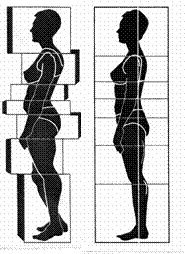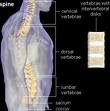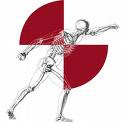
Back pain ranks second only to headaches as the most frequent pain location.
Four out of five adults will experience at least one bout of back pain at some time in their life.
Back pain can occur for no apparent reason and at any point on your spine.
The most common site for pain is your lower back because it bears the most weight and stress
.Although back pain is common, it's also quite possible for you to prevent most back problems with simple steps such as exercise and adopting new ways to sit and stand.
Even if you've injured your back before, you can learn techniques to help avoid recurrent injuries.
Limited rest combined with appropriate exercise and education is often the best course.
Acute back pain often goes away by itself in a few days or weeks.
An ice bag or hot water bottle applied to the back may also help to alleviate pain. Prolonged bed rest is not beneficial because it weakens muscles
. Exercising with Back Pain
Recommendations for preventing initial and recurring episodes of back pain include:
regular exercise stretching before participation in sporting activities
losing weight maintaining correct posture
using comfortable, supportive seats while driving
sleeping on the side with knees drawn up or on the back with a pillow under bent knees
Homeopathy
Many of the herbs used for pain relief use the same biochemical pathways as the non-opiate pain-relieving drugs, but they are not as effective. However, on the positive side, many of these herbs have multiple effects. Their antispasmodic and circulation-promoting constituents may make up for what these plants lack in prostaglandin- suppressing strength. Herbal formulas that combine prostaglandin-suppressing, antispasmodic, sedative, and antidepressant plants are commonly prescribed by professional herbalists in North America, Great Britain, and Australia
Chronic pain often creates other problems besides the pain itself. These may include: tension, spasm, insomnia, and depression. And while conventional pain medications may remedy one or two of these side effects, some formulas of herbs can address them all. A pain-reliever, an antispasrnodic, a sedative, and an antidepressant may all be in included in a typical herbal formula created by a medical herbalist. For example, one herbal combination may include equal parts of willow bark (for pain), cramp bark (for spasm), valerian (a sedative), and St. Johns wort (an antidepressant).
For example, if related to drink
. .
Hot, moist herbal packs help relieve the pain and increase blood circulation on painful areas, while herbal teas, juices and extracts soothe muscles and nerves.
Camomile has a calming effect on smooth muscle tissue. Take it as 1-3 cups of tea, 10-20 drops of extract in a cup of liquid or 1-3 capsules daily.
Bromelain (pineapple extract) is a powerful anti-inflammatory (take 2-3 g daily at first, then 1-2 g as the pain eases). Other anti-inflammatories, effective when drunk as teas, are valerian, St. John's wort, and Jamaican dogwood.
Horsetail not only heals and builds connective tissue, but also normalizes the bowels and alleviates lower-back pain, much of which can be traced to a dysfunctional intestinal tract. Take internally as per camomile.
Burdock soothes the pain and purifies the blood. Take 1-3 capsules or 10-25 drops of extract in 1 cup liquid daily.
If the muscle tension is due to emotional stress, take borage, St. John's wort, lemon balm or valerian teas.
Fresh yarrow juice is excellent for strengthening back muscles.
Use a white or black mustard seed pack for more intense heat. A mustard pack should not be left on for more than ten minutes because it can irritate the skin.
An infusion of meadowsweet three times a day combined with a rub on the area with lobelia and cramp bark is useful for physical strain or rheumatic problems.
Here are some herbs that are useful in pain relief.
Hot Peppers
Cayenne pepper (Capsicum spp.) is used in formulas for liniments and plasters in the folk medicine. Red pepper contains a pain-relieving chemical--capsaicin--that is so potent that a tiny amount provides the active ingredient in some powerful pharmaceutical topical analgesics. One product, Zostrix, contains only 0.025 percent capsaicin.
The exact mechanism in which red pepper works is not known. But it sure does work. Red pepper's effectiveness may be due to:
Capsaicin interferes with our pain perception
Capsaicin trigger release of the body's own pain-relieving endorphins
Salicylates present in red pepper.
How to Apply
1. You can buy a commercial cream containing capsaicin and use that.
2. Mash a red pepper and rub it directly on the painful area.
3. Take any white skin cream that you have on hand such as cold cream. Mix in enough red pepper to turn it pink.
4. Place 1 ounce of cayenne pepper in a quart of rubbing alcohol. Let the mixture stand for three weeks, shaking the bottle each day. Then, apply to the affected part during acute attacks.
5. Place 1 ounce of cayenne pepper in a pint of boiling water. Simmer for half an hour. Do not strain, but add a pint of rubbing alcohol. Let cool to room temperature. Apply as desired to the affected part.
Caution: Do not ingest any of these remedies. Wash your hands thoroughly after preparing or using red pepper. Don't get it in your eyes.
Some people are sensitive to this compound. Test it on a small area of skin to make sure that it's okay for you to use before using it on a larger area. If it seems to irritate your skin, discontinue use.
Cramp Bark and Black Haw
For the treatment of spasmodic pain, both cramp bark (Viburnum opulus) and black haw (Viburnum prunifolium) have been used in American Indian medicine. The Indians used cramp bark to treat both menstrual pain and muscle spasm. Cramp bark and black haw were also used hisatorically for arthritic or menstrual pain. The plants contain the antispasmodic and muscle-relaxing compounds esouletin and scopoletin. The antispasmodic constituents are best extracted with alcohol. So use tinctures rather than teas. Black haw also contains aspirin- like compounds.
Directions: Mix equal parts of cramp bark and black haw tinctures. Take between 1 and 4 droppers every two or three hours for up to three days.
Willow Bark
Willow bark (Salix alba) was used for treating pain by the ancient Greeks more than 2,400 years ago. American Indians throughout North America used it as a pain reliever even before the arrival of the European colonists. Investigation of salicin, a pain-relieving constituent in willow bark, led to the discovery of aspirin in 1899. The most important active constituent is salicin, but other anti-inflammatory constituents also appear in the willow bark.
Peppermint (Mentha piperita) and other mints.
The compounds menthol and camphor are found in many over-the-counter backache medications. They are chemicals that can help ease the muscle tightness that contributes to many bad backs. Menthol is a natural constituent of plants in the mint family, particularly peppermint and spearmint, although the aromatic oils of all the other mints contain it as well. Camphor occurs in spike lavender, hyssop and coriander.
Ginger
Ginger is used to treat various sorts of pain in the folk medicine of China and India. It is an important pain medication in contemporary Arabic medicine. Ginger contains 12 different aromatic anti-inflammatory compounds, including some with mild aspirin-like effects.
Directions: Cut a fresh ginger root (about the size of your thumb) into thin slices. Place the slices in a quart of water. Bring to a boil, and then simmer on the lowest possible heat for thirty minutes in a covered pot. Let cool for thirty more minutes. Strain and drink 1/2 to 1 cup, sweetened with honey, for taste if needed.
Rosemary
Drinking rosemary tea for pain is a remedy used in the contemporary Hispanic folk medicine of Mexico and the Southwest. Its leaf also contains four anti-inflammatory substances---camosol, oleanolic acid, rosmarinic acid, and ursolic acid. Carnosol acts on the same anti-inflammatory pathways as both steroids and aspirin; rosmarinic acid acts through at least two separate anti-inflammatory biochemical pathways; and ursolic acid, which makes up about 4 percent of the plant by weight, has been shown in animal trials to have anti-arthritic effects.
Directions: Put 1/2 ounce of rosemary leaves in a 1-quart canning jar and fill the jar with boiling water. Cover tightly and let it stand for thirty minutes. Drink a cup as hot as possible before going to bed, and have another cupful in the morning before breakfast.
Epsom Salt Baths
Folk traditions call for Epsom salt baths to relieve pain. Epsom salt was reputed to have magical healing properties. Epsom salt is primarily magnesium sulfate and has been used medicinally in Europe for more than three hundred years. The heat of an Epsom salt bath can increase circulation and reduce the swelling of arthritis, and the magnesium can be absorbed through the skin. Magnesium is one of the most important minerals in the body, participating in at least 300 enzyme systems. Magnesium has both anti-inflammatory and anti-arthritic properties.
Directions: Fill a bathtub with water as hot as can be tolerated. Add 2 cups of Epsom salts. Bathe for thirty minutes, adding hot water if necessary to keep the bath water warm.
Angelica
Various species of angelica have been used to quiet pain by American Indians throughout North America. The European species (Angelica archangelica) and the Chinese species (Angelica sinensis) have been used in the same way in the folk medicine of Europe and China respectively. The Chinese species is sometimes sold in North America under the names dang gui or dong quai. All species contain anti-inflammatory, antispasmodic, and anodyne (pain- relieving) properties. The European species of angelica has been used in European folk medicine since antiquity, as has the Chinese species in Chinese medicine.
Directions: Place 1 tablespoon of the cut roots of either species of angelica in a pint of water and bring to a boil for two minutes in a covered pot. Remove from heat and let stand, covered, until the tea cools to room temperature. Drink the pint in 3 doses during the day.
What ever you decide to do with regard to treating your medical condition, always consult with your GP before starting any alternative therapies or medicines.
 Spinal fractures that occur as a result of osteoporosis are actually quite common, occurring in approximately 300,000 people in the UK each year. The problem is that the fracture is not always diagnosed instead, the problem is often just thought of as general back pain, such as from a muscle strain or other soft tissue injury, or as a common part of aging. Because of this, approximately two thirds or 200,000 of the vertebral fractures that occur each year are not diagnosed and therefore not treated.
Spinal fractures that occur as a result of osteoporosis are actually quite common, occurring in approximately 300,000 people in the UK each year. The problem is that the fracture is not always diagnosed instead, the problem is often just thought of as general back pain, such as from a muscle strain or other soft tissue injury, or as a common part of aging. Because of this, approximately two thirds or 200,000 of the vertebral fractures that occur each year are not diagnosed and therefore not treated.


















